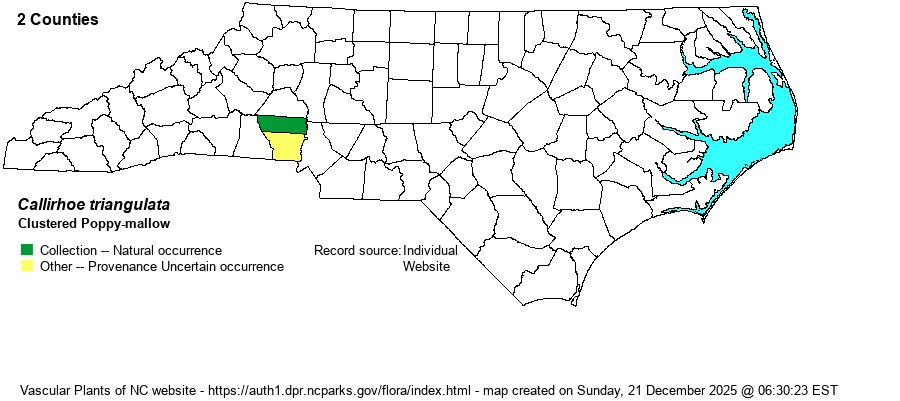| Author | (Leavenworth) A. Gray | |
| Distribution | Reported as native in NC by Weakley (2024) in the Coastal Plain and Piedmont, with no other information given. The BONAP map shows records from Lincoln and Gaston counties, in the southern Piedmont. However, the SERNEC database has no NC specimens, as of May 2025, nor are there any NC photos on iNaturalist. In August 2025 Scott Ward found a specimen at the New York Botanical Garden herbarium (NY) taken "on the Catawba [River] in Lincoln Co., N. Car. fide Curtis, M.A. 1849." Thus, we now have positive evidence of this species in NC, though from about 175 years ago. For the time being, we map Gaston County as Provenance Uncertain, until a specimen turns up. It may well be adventive in NC, but it is best to provide a species account and treat it as "native", following Weakley (2024).
This species has its main range in the Midwest, from WI south to eastern MO; with a separate disjunction from eastern MS eastward into GA and western SC. Exactly where the species is truly native or not -- in the Southeastern states -- is blurred. | |
| Abundance | Extremely rare, if still present. There seems to be no information that the species currently exists in NC. The NCNHP ranks it as SH (Historical). This species has no State Status given by NC NHP, but it seems best to suggest SR-P (Significantly Rare - Peripheral). | |
| Habitat | This is a species of sandy soil. Weakley (2024) states, for the Southeast: "Longleaf pine sandhills, sandy scrub, and other dry, open habitats". | |
| Phenology | Blooms in July and August, and fruits shortly after flowering. | |
| Identification | The species in the genus Callirhoe, mostly called poppy-mallows, are quite showy species with large flowers, often purple -- at first glance looking like a Wild Geranium (Geranium maculatum). This is a sprawling, much-branched herb, growing to 2 feet tall, with generally ascending stems. The stems and leaves are strongly hispid-hairy. The relatively few stem leaves are alternate, triangular, with some having side lobes. They have crenate to toothed margins and mostly truncate bases; the blades are about 5 inches long and 2-2.5 inches wide. The showy flowers are in terminal panicles, with each having 5 petals, bright purple, obovate (with almost squared-off tips), and a spread of about 2-2.5 inches across. The center of the flower is white. This species cannot be confused with any other native NC species, owing to the large purple flowers, triangular leaves, and growing in sandy soil in full sun; however, there are several other Callirhoe species that are native farther to the west. If this species is seen or known to occur in NC, please collect a specimen or part of a specimen, or photograph it, for current documentation. | |
| Taxonomic Comments | None
| |
| Other Common Name(s) | Sand Poppy-mallow | |
| State Rank | SH | |
| Global Rank | G3 | |
| State Status | [SR-P] | |
| US Status | | |
| USACE-agcp | | |
| USACE-emp | | |

